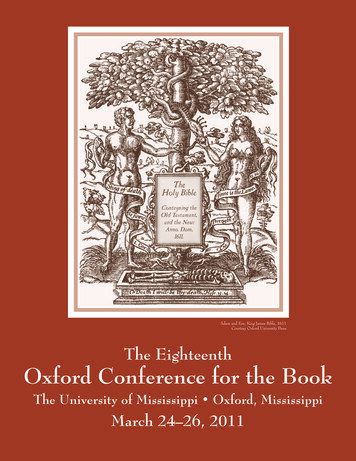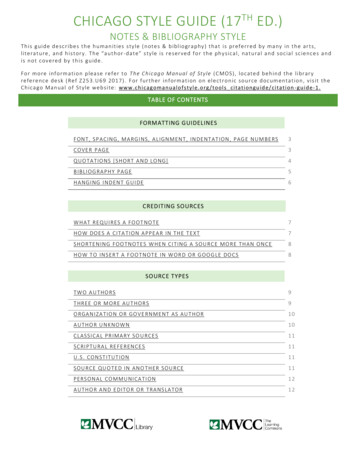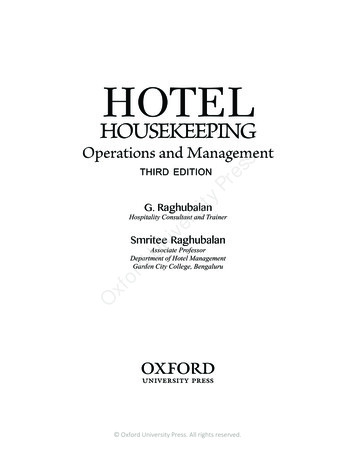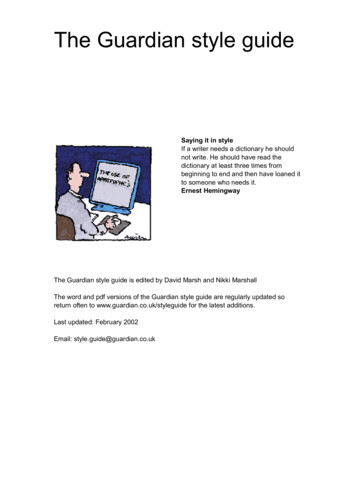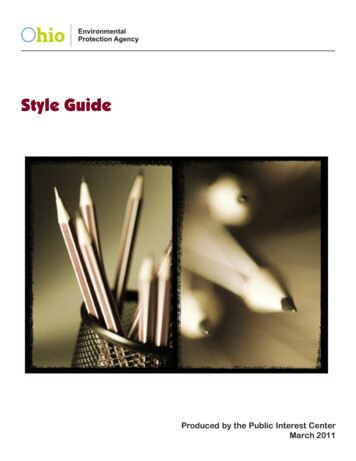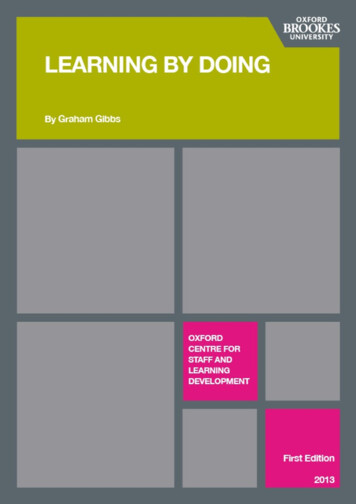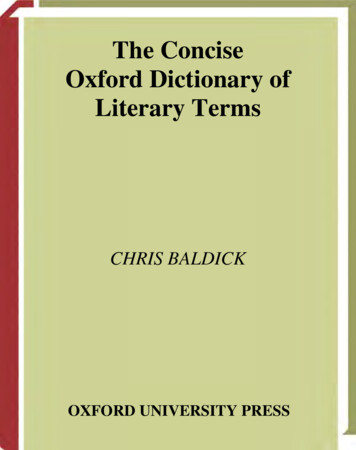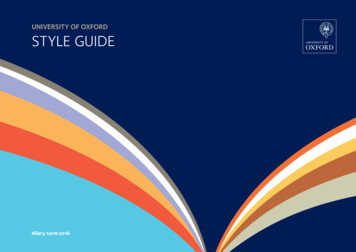
Transcription
UNIVERSITY OF OXFORDSTYLE GUIDEHilary term 2016
UNIVERSITY OF OXFORDSTYLE GUIDEContents1 IntroductionObjectives of the style guide 1How the guide is arranged 1How to use the guide 1What is/is not included in the style guide 1Quick reference guide 12 Abbreviations, contractions Abbreviations 2and acronymsContractions 2Acronyms 2Specific abbreviations 34 Capitalisation7 NumbersHow to write numbers 7Times 7Dates 8Spans of numbers and years 89 PunctuationApostrophe 9Brackets 10Bullet points 11Colon and semicolon 11Comma 12Dashes and hyphens 13Ellipsis 15Full stop, exclamation markand question mark 15Quotation marks 1617 Names and titlesGeneral titles 17Oxford-specific titles 17Other titles 18Combining titles 19Postnominals 2021 Highlighting/emphasisingtextBold 21Italics 21Underlining 2122 Word usage and spellingList of Oxford places 22Common confusions in word usage 23Spelling 24Plurals 24American English 25Tricky words 2525 MiscellaneousPersonal pronouns 26Plural or singular? 26Footnotes 27Addresses, phone numbers, websites etc 27
The University of Oxford Style Guide aims to provide a guide to writing andformatting documents written by staff on behalf of the University (or oneof its constituent departments etc). It is part of the University’s brandingtoolkit (www.ox.ac.uk/branding toolkit) which enables the University’sformal documentation to be presented consistently across all communications.What is/is not included in the style guideAlthough this style guide is freely available online it has not been written withpublic or external use in mind. The University of Oxford Style Guide does notpurport to compete with OUP’s professional writing guides and dictionaries.The general ruleIf there are multiple (correct) ways of doing something, choose the one whichuses the least space and the least ink. For instance:Objectives of the style guideWe have three main objectives in writing this style guide: to provide an all-purpose guide to consistent presentation for Universitystaff in written communications to review the guide at least once a year, ensuring that it properly reflectsmodern usage and is fit for purpose, and to update it as required as part of the review process, to invite proposals from members of theUniversity who disagree with any existing guidance, and to act as anarbiter on those cases.How the guide is arrangedThe style guide is intended to be read as an interactive PDF, where it canbe cross-referenced. However, the PDF can be printed if preferred for easeof reference.When we update the style guide we will highlight on the main webpage(www.ox.ac.uk/styleguide) whether anything has changed as well aschanging the term listed on the front cover.How to use the guide search for a specific term (such as semicolon) browse through a section (such as Punctuation)The guide does not tell you how to write. We aim to help you write correctly,and to encourage consistency across the University’s written communications.Quick reference guide close up spaces and don’t use full stops in abbreviations (eg 6pm) use lower case wherever possible only write out numbers up to ten and use figures for 11 onwards.University of Oxford or Oxford University?These terms are interchangeable and can either be alternated for variety orkept the same for consistency.University branding informationOther information on University branding, including the use of the logo, canbe found online at www.ox.ac.uk/branding toolkit.New: one-page style guideFor ease of use, we have created a quick reference A–Z with themost commonly requested information. Download your guide fromwww.ox.ac.uk/styleguide.QueriesIf you have any queries about using this guide, please contact:Public Affairs DirectorateUniversity of OxfordWellington SquareOxford OX1 2JDgazette@admin.ox.ac.ukUniversity of Oxford Style Guide Introduction1IntroductionIntroduction
Abbreviations, contractions and acronymsGeneral ruleDon’t use full stops after any abbreviations, contractions or acronyms andclose up space between letters.AbbreviationsMedical Sciences Med SciDoctorate of Philosophyante meridiem ampost meridiempm DPhilContractionsMister MrDoctor DrThe Reverend2Master of Arts The Revd BBC MAAcquired Immune Deficiency SyndromeMathematical, Physical and Life Sciences AIDS MPLSPlanning and Resource Allocation CommitteePro-Vice-Chancellor PRAC PVCPortable Document FormatThese are formed by omitting letters from the middle of a word.StreetThese are formed from the initial letters of words (whether the result ispronounceable as a word or as a series of letters) and should be writtenas a single string of upper-case letters.British Broadcasting CorporationThese are formed by omitting letters from the end of a word.SaintAcronyms PDFWhen using an acronym that may be unfamiliar to your readers, spell it outin full the first time it is mentioned, with the acronym following in brackets;thereafter, use the acronym alone.The decision was made by the Planning and Resource AllocationCommittee (PRAC). There are several meetings of PRAC every term. St StUniversity of Oxford Style Guide Abbreviations, contractions and acronyms
Specific abbreviationsJohnson & JohnsonUehiro Foundation on Ethics and Educationpeople’s initialsUse a space to separate each initial.J R R TolkienC S LewismeasurementsWhen discussing large numbers in text, it is fine to use k/m/bn as shorterways of spelling out 1,000/1,000,000/1,000,000,000 (or writing out ‘onethousand’/‘one million’/‘one billion’), as long as you are consistent throughoutthe document. For multiple millions/billions you can use a mixture of words andnumbers (eg 7 million, 8bn); again, ensure you are consistent throughout.referencesPage numbers should be referred to with a single ‘p’ for a single page referenceor ‘pp’ for a range of pages; line references with ‘l’ and ‘ll’. In both cases closeup the numbers to the ‘p’ or ‘l’.Note, however, that some typefaces do not differentiate between a lowercase ‘l’ and a number 1. In such cases, leave a space between the ‘l’ or ‘ll’ andthe numbers.names of universities, degrees etcSee Names and titles for details.Latin abbreviationsIf you are using Latin abbreviations, make sure you know what they mean andwhen to use them. Do not use full stops after them and don't italicise them –see the Highlighting/emphasising text section for when to italicise.etc [et cetera] – means ‘and the rest’; use to indicate the continuation of a listOxford offers many language courses: Russian, French, Spanish etc[the list could continue with the other language courses offered].eg [exempli gratia] – means ‘for example’ or ‘such as’; use with examples whichare not exhaustive (and do not follow with a comma)Oxford offers many language courses, eg Russian, French, Spanish[those are some, but not all, of the language courses offered].ie [id est] – means ‘that is’; use with definitions or lists which are exhaustive(and do not follow with a comma)Catch a Blackbird Leys bus, ie numbers 1, 5 or 12[those are the only buses which go to Blackbird Leys].ibid [ibidem] – means ‘in the same place’; use when making a subsequentreference/citation to a publication or other source mentioned in theimmediately preceding note (ie no references to anything else have appearedin between)For a fuller explanation of telepathy, see Brown [Speaking with theMind, Chicago (1945) p125]; Brown also gives further information oncats and telepathy [ibid, p229].The first mention of orcs in The Fellowship of the Ring is on p21 of the1954 edition.Dates of term are published on pp7–8 of the Examination Regulations.University of Oxford Style Guide Abbreviations, contractions and acronyms3Abbreviations, contractions and acronymsampersandsAmpersands should only be used if they are part of official titles or names.Otherwise, spell out ‘and’.
CapitalisationGeneral ruleDo not use a capital letter unless it is absolutely required.Specific Oxford-related wordsacademic termsCapitalise the name but not the word ‘term’.The Michaelmas term begins in October.The coldest part of the year usually falls in Hilary term.Finals take place in Trinity term.If abbreviating term names, use MT, HT and TT.The post is vacant from MT 2014 until TT 2015.ChancellorAlways capitalise when referring to the Chancellor of the University.Chris Patten is the Chancellor of the University.The University has had 192 Chancellors since 1224.collegeCapitalise only when used as part of the title of a college, not when referringto an institution without using its full name.Exeter College was founded in 1314. The college is one of the oldest inOxford.Exeter College was founded in 1314. The College is one of the oldest inOxford.collegiate UniversityCapitalise ‘University’ but not ‘collegiate’.We are seeking opinions from all members of the collegiate University.course namesCapitalise the name of a subject when it is used as part of a course title, but not if it isused in other contexts. Also capitalise the subject name when referring to the faculty ordepartment which teaches it.While studying economics, she focused on the theories of Adam Smith.David Cameron studied Philosophy, Politics and Economics at Brasenose.A degree in history teaches you to think analytically.The Law Faculty at Oxford has an excellent reputation.She did Law at Oxford.CouncilAlways capitalise when referring to the executive governing body of the University ofOxford. When referring to any other council, such as a local authority, capitalise only whenusing the full name of the authority.There are four external members of Council, whose membership is approved by Congregation.Planning applications are handled by Oxford City Council. You can apply via thecouncil’s website at www.oxford.gov.uk.degreesCapitalise the level of a degree only when referring to a specific qualification or course, butnot when referring to any qualification at that level.She finished her Master’s in Linguistics and started a DPhil in Philology.We offer many masters’ degrees, and many people go on to doctorates.departmentCapitalise only when used as part of the title of a department, not when referring to adepartment without using its full name.The Department of Computer Science was previously known as the Oxford UniversityComputing Laboratory. Both undergraduates and postgraduates study in thisdepartment.The Department for Work and Pensions has to make significant cuts this year, as domany government departments.4University of Oxford Style Guide Capitalisation
There are four academic divisions of the University: Humanities, Mathematical,Physical and Life Sciences, Medical Sciences and Social Sciences.The Medical Sciences Division is based mainly in Headington. The division’shead is Alastair Buchan.ReverendCapitalise both ‘Reverend’ and ‘The’ (as well as other parts of the title).See p19 for further information.My tutor is The Reverend John Smith/The Very Reverend John Smith.small capsDo not use small caps, even for BC and AD.Egypt’s Old Kingdom period began c2700 BC.facultyCapitalise only when used as part of the title of a faculty, not when referring to afaculty without using its full name.The Faculty of English is based in Manor Road. The faculty’s phone numberis 271055.fellowCapitalise only when used as part of an academic’s formal title, not when referringto fellows in general.There are ten Fifty-Pound Fellows at All Souls.At its foundation, provision was made at All Souls for 40 fellows.At its foundation, provision was made at All Souls for 40 Fellows.names with prefixesFollow the preference of the individual, if known; if not, use lower case for theprefix. Alphabetise by the prefix.Dick Van Dyke is a star of daytime TV.Jan van Eyck painted in the 15th century.professorCapitalise only when used as part of an academic’s formal title, not when referringto professors in general. See also p17.tutorCapitalise only when used as part of an academic’s formal title, not when referringto tutors in general.The Oxford tutorial system creates strong ties between students and theirtutors.Dr Obadiah Braithwaite is the Tutor in Embroidery at Magdalen.universityCapitalise only when used as part of the title of a university or when referring tothe University of Oxford (both when ‘University’ is used as a noun and when it isused as an adjective).Oxford University is a large employer. The University has 10,000 staffmembers.The University has four academic divisions.The event is open to all members of the collegiate University.The largest University division is Medical Sciences.Funding for universities has been cut recently.She attended the University of Liverpool to study English. It’s a wellrespected university and course.It is common for Oxford professors to publish their works in learned journals.The Omega Solution is the latest contribution to research in the field byProfessor Stephanie Archibold.University of Oxford Style Guide Capitalisation5CapitalisationdivisionCapitalise only when used as part of the title of a division, not when referring to adivision without using its full name.
Vice-ChancellorCapitalise both parts of ‘Vice-Chancellor’ whenever it is used. If referring to theVice-Chancellor-elect (the incoming Vice-Chancellor during the period betweentheir appointment and their admission), note that ‘elect’ is not capitalised.Previous Vice-Chancellors at Oxford have included John Fell and Benjamin Jowett.According to Statute IX, the Vice-Chancellor-elect is an officer of the University.Other wordsearthCapitalise when referring to the name of the planet but not when referring to theground/soil etc.TitlesPeopleSee Names and titles for details.Books/films/songs/games etcCapitalise the first word of the title, and all words within the title except articles (a/an/the), prepositions (to/on/for etc) and conjunctions(but/and/or etc). See Highlighting/emphasising text for details on italicising andPunctuation for quotation mark advice.The Last MohicanFar from the Madding CrowdOne day we will be commuting between the Earth and Mars.Gone with the WindHis down-to-earth personality appealed to the masses.World of WarcraftgovernmentOnly capitalise when used as part of the title ‘Scottish Government’The UK government is out of touch with the people.Elected governments are not always able to achieve as much as they would like.The Scottish Government used to be known as the Scottish Executive and isbased in Edinburgh.Wi-Fi‘Wi-Fi’ is a registered trademark of the Wi-Fi Alliance and should always be writtenin this format.Wi-Fi is available in many University buildings.There are wifi points across the University.Grand Theft Auto V‘Always Look on the Bright Side of Life’‘Always Look On The Bright Side Of Life’SubtitlesCapitalise subtitles only if the original title is printed in that way.The Tale of Samuel Whiskers, or The Roly-Poly PuddingDr Strangelove or: How I Learned to Stop Worrying and Love the BombHeadlines, journal articles, chapter titles and lecture titlesOnly capitalise the first word, any proper nouns and the first word following a fullstop/question mark/exclamation mark.‘Who speaks for climate? Making sense of media reporting on climate change’Rock rafts could be ‘cradle of life’‘Multiplicity of data in trial reports and the reliability of meta-analyses:empirical study’WebpagesSee p27 for advice on capitalisation of URLs, email addresses etc.6University of Oxford Style Guide Capitalisation
How to write numbersSpell out whole-number words for one to ten; use figures for numbersabove ten.Always use figures and symbols for percentages, measurements and currency.Use commas to punctuate large numbers.Question 12 is worth 10% of the available marks.There were two people in the queue ahead of me, and six behind me.20 per cent of commuters use their cars.I need to buy Christmas presents for 12 people this year.The average height of a woman in the UK is 1.61m.Use a combination of a figure and a word for very large round numbers(such as multiple millions/billions etc), or abbreviate it to ‘m’, ‘bn’ etc.The cost, at 5.99, was less than their overall budget of 50.The population of New York City is estimated to be 8,008,278.The population of the earth is now 7 billion people.The population of the earth is now 7bn people.The budget came in at just under 2m.If there are a lot of figures in a paragraph or text, some above ten and somebelow, use figures throughout to allow easy comparison by readers.There were 2 people in the queue ahead of me, and 22 behind me.The queues for other advisors had 10, 3 and 12 people.Spell out words for ‘first’, ‘second’ and so on up to and including ‘tenth’; usenumbers and ‘st’/ ‘nd’/ ‘rd’/ ‘th’ for larger ordinal numbers. Don’t use superscript(to prevent problems with line spacing).She was the first person from her school to get a place at Oxford.He got an upper second, to his relief.She got a 3rd class degree.The 17th president of the United States was Andrew Johnson.TimesUse either the 12- or 24-hour clock – not both in the same text. The 12-hourclock uses a full stop between the hours and minutes; the 24-hour clock usesa colon and omits am/pm.The lecture starts at 11.30am and ends at 1pm.The lecture starts at 11:30 and ends at 13:00.The lecture starts at 11.30am and ends at 13:00.The lecture starts at 16:00pm.Use ‘noon’ or ‘midnight’ instead of ‘12’, ‘12 noon’ or ‘12 midnight’.The closing date for applications is noon on 12 July.If using the 12-hour clock, don’t use additional ‘.00’ for times on the hour,and close up space between the number and the ‘am’ or ‘pm’.The lecture starts at 9am.The lecture starts at 11.30am and ends at 1pm.The lecture starts at 9.00am.The lecture starts at 9 am.University of Oxford Style Guide Numbers7NumbersNumbers
DatesAlways put the date before the month.Easter this year is on 13 April.Easter this year is on April 13.Don’t use ‘th’ etc with dates – just the number and month – and never precedethe number with ‘the’.Easter this year is on 13 April.11th November is Armistice Day.Armistice Day is on the 11 November.Use days with dates only for emphasis or the avoidance of confusion/ambiguity.The wedding is on 30 December.The wedding is on Saturday 20 December.The Modern Superstitions conference is on Friday 13 April.Spans of numbers and yearsShorten periods where it is not ambiguous to do so and use the shortest textpossible. However, do not elide numbers between 11 and 19, which must alwaysbe written in full (as they would be spoken).The ‘short twentieth century’ refers to the period 1914–91.The First World War (1914–18) was shorter than the Second World War(1939–45).The First World war lasted from 1914–8.The professorship was held 1993–5 by Alice Jenkins.Inner-city flats cost 100– 200,000. [Price could start at 100 or 100,000.]To refer to an academic or financial year, you can use either the format‘2015–16’ or ‘2015/16’ – but ensure you are consistent throughout the text.The Proctors for 2016–17 will be elected in the 2015–16 academic year.Profits are up year on year: the company did better in 2014/15 than in2013/14.If using ‘from’ with a start date/time, always use ‘to’ to indicate the end date/time rather than an n-dash; alternatively, just use an n-dash without ‘from’.Michaelmas term runs from October to December.Michaelmas term runs October–December.Michaelmas term runs from October–December.If referring to decades, use the century as well as the decade fordisambiguation purposes, unless the context makes the meaning clear.Was unemployment higher in the 90s or the 00s?The roaring twenties ended with the Wall Street Crash.8University of Oxford Style Guide Numbers
General ruleUse as little punctuation as necessary while retaining the meaning of the sentence.Apostropheto indicate possessionUse ’s after singular nouns, plural nouns which do not end in s and indefinite pronouns.Some place names have an apostrophe and some don’t – this can’t be predictedand must be checked.All Souls CollegeEarls CourtSt Peter’s CollegeFrank’s bookLand’s Endanybody’s guessUniversity of St AndrewsThe children’s play area is next to the men’s toilet.Use just ’ after plural nouns ending in s.Strong tea is sometimes called builders’ tea.If a name already ends in s or z and would be difficult to pronounce if ’s were addedto the end, consider rearranging the sentence to avoid the difficulty.Jesus’s methods were unpopular with the ruling classes. ORThe methods of Jesus were unpopular with the ruling classes.In compound nouns and where multiple nouns are linked to make one concept,place the apostrophe at the end of the final part (and match it to that noun).the Archbishop of Canterbury’s tortoisemy mother-in-law’s doghis step-brothers’ carsLee and Herring’s Fist of FunDo not use an apostrophe in its with the meaning ‘belonging to it’ (this is analogouswith his/hers/theirs): note that it’s is a contraction of ‘it is’.The cat has been out in the rain and its paws are muddy.The cat has been out in the rain and it’s muddy.The cat has been out in the rain and it’s tail is wet.University of Oxford Style Guide PunctuationSome street names have an apostrophe (usually linked to saints’ names fromnearby churches); these are also idiosyncratic.There is a famous pub on St Giles’.St Giles’s splits into Woodstock and Banbury Roads.Christ Church is on St Aldate’s.St Michael’s Street is a through road for bicycles.Use apostrophes with noun phrases denoting periods of time (use an apostrophe ifyou can replace the apostrophe with ‘of’).He took a week’s holiday [holiday of a week].You must give three months’ notice [notice of three months].It will arrive in three weeks’ time.It will arrive in three weeks.It will arrive in two months time.But do not use an apostrophe in adjectival phrases.She was eight months pregnant when she went into labour.It arrived 12 weeks ago.He is three years’ old.9PunctuationPunctuation
Apostrophe (cont)to indicate that letters have been omitted (contractions)Use an apostrophe in the position the omitted letters would have occupied,not where the space was between the original words.I don’t like cheese. [ do not]I do’nt like cheese. [ do not]He wouldn’t do that.Do not use an apostrophe before contractions accepted as words in their ownright.He is on the phone.He had swine flu.Bracketsparentheses/round brackets ( )Use in place of a pair of dashes or commas around a non-defining phrase(one which adds extra information, a translation, dates, an explanation ora definition).The library (which was built in the seventeenth century) needs to berepaired.It was (as far as I could tell) the only example of its kind.Magdalen College (founded in 1458) has a herd of deer.The tactic of Blitzkrieg (which means ‘lightning war’ in German) wasused in the invasion of Poland in 1939.Preheat the oven to 350 F (180 C).There is no vaccine for all types of ‘flu.Do not use an apostrophe to make a plural, even with a word/phrase that isnot usually written in the plural or which appears clunky. All of the followingexamples take an s as normal in English to make their plurals.Three video’s for a tenner.I trust all the MP’s.using other punctuation with bracketsInclude full stops/exclamation marks/question marks/quotation marksbefore the closing bracket only if the complete sentence/quote is in brackets;otherwise, punctuate after the closing bracket.The last bus today is at 4.45 (which is earlier than usual).The last bus today is at 4.45. (That’s earlier than usual.)Clothes were colourful in the 1970’s.CD’s will soon be obsolete.This is a list of do’s and don’t’s.We invited several VIP’sTo clarify something which will look odd if an s is added, consider italicisingit or placing it in single quotation marks.Subtract all the xs from the ys.Dot the ‘i’s and cross the ‘t’s.square brackets [ ]Use to enclose comments, corrections, references or translations made by asubsequent author or editor.An article referring to the restrictions placed by some airlines onthe appearance of female cabin crew stated that even footwear wasproscribed [sic].I have been responsible in the real sense, that I have had the blame foreverything that has gone wrong. [Laughter and cheers.]This was quoted by Brown [1940, Chicago].A list of dos and don’ts. [or A list of dos and don’ts.]angle brackets and curly brackets { }These are used for technical purposes – only use them in the correct context.10University of Oxford Style Guide Punctuation
Bullet points2014 concert performers: Slade The Smiths Metallica the Spice GirlsIf the bullet points form a complete sentence with preceding text, add a fullstop to the end of the last point.We are holding a concert in 2016, at which the following acts willperform: Slade The Smiths Metallica the Spice Girls.If text inside the bullet point is a complete sentence in its own right, add asemicolon to the end of each point, ‘or’ or ‘and’ (depending on the sense ofyour sentence) to the end of the penultimate point, and a full stop to the endof the last one.The following will be considered good reasons for missing the finalmeeting of the year: there was a postal strike. This only applies if the postal strike tookplace before the date of the meeting and if you have not signed upfor email alerts; you are absent as a result of illness; you are unable to attend because of problems with public transport(proof of this will be required); there is something more interesting happening elsewhere which youwould rather attend; or you have obtained a ticket to see the Spice Girls in concert.Colon and semicolonUse a colon to introduce a subclause which follows logically from the textbefore it, is not a new concept and depends logically on the preceding mainclause.PunctuationDon’t punctuate the end of bullet points which are a list of items.When I was young, I went on two holidays: to the Lake District and toCornwall.A new drink was introduced to Britain: tea.Do not use a colon if the two parts of the sentence are not logically connected.I used to be slim: I will try to lose weight.I would like to be slim: I will try to lose weight.We were in trouble this time: we’d never been in trouble before.We were in trouble this time: the lid had come right off.There are two parts to this sentence: the first part, which precedes thecolon, and the second part, which doesn’t.Use a semicolon to link two related parts of a sentence, neither of whichdepends logically on the other and each of which could stand alone as agrammatically complete sentence.The best job is the one you enjoy; the worst job is the one you hate.It is a far, far better thing that I do, than I have ever done; it is a far, farbetter rest that I go to, than I have ever known.Use semicolons in place of commas in a complicated list or sentence if it willimprove clarity, particularly if list items already include commas.We plan to review the quality of the research of the department,including its participation in interdepartmental, interdivisional andinterdisciplinary activities; its research profile and strategy; and futurechallenges and opportunities.I visited the Ashmolean Museum, Oxford; the Victoria and AlbertMuseum, London; and the Pencil Museum, Keswick.University of Oxford Style Guide Punctuation11
CommaUse a pair of commas to surround a non-defining clause (one which addsdescriptive information but which can be removed without losing the meaningof the sentence) – note that only ‘which’ or ‘who’ can be used in this type ofclause, not ‘that’.The library, which was built in the seventeenth century, needs to berepaired.The man, who climbed the tower without a safety harness, died ofold age.Do not use commas to surround a defining clause (which cannot be removedwithout losing the meaning of the sentence) – note that ‘which’ or ‘who’ can bereplaced by ‘that’ in this type of clause.The library which was built in the seventeenth century needs to berepaired [but the library which was built in the eighteenth centurydoes not].The man that climbed the tower without a safety harness died of old age[but the other man died in a different way].He asked his friend Sam to be his second [not any of his other friends].Use commas to surround a non-defining word or phrase (which addsinformation but could be omitted without changing the sense of the sentence),and follow the non-defining word/phrase with a single comma if it is at thestart of the sentence.Shakespeare, the prolific playwright, might not have existed.A prolific playwright, Shakespeare might not have existed.He asked Sam, his friend, to be his second [not the Sam who is hisbarber].The prime minister, David Cameron, is an alumnus of Brasenose.Do not use a comma where defining information is used at the startof a sentence.The prolific playwright Shakespeare might not have existed.The prolific playwright, Shakespeare might not have existed.His friend Sam was his second.His friend, Sam was his second.Defining vs non-defining informationDo not use a comma to join two main clauses, or those linked by adverbsor adverbial phrases (eg ‘nevertheless’, ‘therefore’, ‘however’). This is sometimesreferred to as ‘comma splicing’. Either use a semicolon or add a co-ordinatingconjunction (eg ‘and’, ‘but’, ‘so’).Shakespeare was popular, and his plays were all profitable.Shakespeare was popular; his plays were all profitable.Shakespeare was popular, his plays were all profitable.Use a comma after an introductory adverb, adverbial phrase or subordinateclause; or use a pair of commas surrounding it if it is in the middle of a sentence.However, it was too late for that.It was, however, too late for that.With his possessions in a bundle, Dick Whittington walked to London.Dick Whittington, with his possessions in a bundle, walked to London.Do not use a comma after a time-based adverbial phrase.After playing tennis all day she was tired.Whenever she
How to use the guide search for a specific term (such as semicolon) browse through a section (such as Punctuation) What is/is not included in the style guide The guide does not tell you how to write. We aim to help you write correctly, and to encourage consistency across the University’s writt

